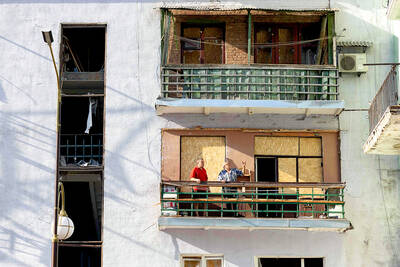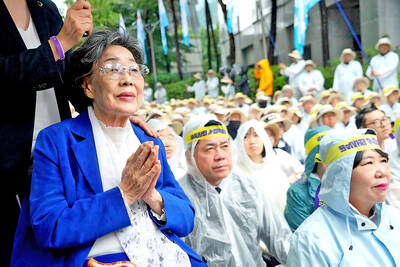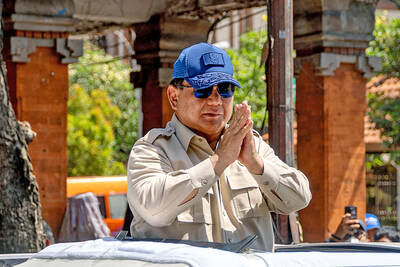The Vatican Museums on Thursday unveiled the last and most important of the restored Raphael Rooms, the spectacularly frescoed reception rooms of the Apostolic Palace that in some ways rival the Sistine Chapel as the peak of high Renaissance artistry.
A decade-long project to clean and restore the largest of the four Raphael Rooms uncovered a novel mural painting technique that Renaissance painter and architect Raphael began, but never completed.
He used oil paint directly on the wall, and arranged a grid of nails embedded in the walls to hold in place the resin surface onto which he painted.

Photo: AP
Vatican Museums officials recounted the discoveries in inaugurating the hall, known as the Room of Constantine, after the last scaffolding came down.
The reception room, which was painted by Raphael and his students starting in the first quarter-century of the 1500s, is dedicated to the fourth-century Roman emperor Constantine, whose embrace of Christianity helped spread the faith throughout the Roman Empire.
“With this restoration, we rewrite a part of the history of art,” Vatican Museums director Barbara Jatta said.
Pope Julius II summoned young Raphael from Florence to Rome in 1508 to decorate a new private apartment for himself in the Apostolic Palace, giving him a major commission at the height of his artistic output.
There were reports that Raphael had wanted to decorate the rooms not with frescoes, but with oil paint directly on the wall, to give the images greater brilliance.
The 10-year restoration of the Room of Constantine proved those reports correct, said Fabio Piacentini, one of the chief restorers.
Vatican technicians discovered that two female figures on opposite corners of the hall, Justice and Courtesy, were actually oil-on-wall paintings, not frescoes in which paint is applied to wet plaster.
They were therefore clearly the work of Raphael himself, he said.
Raphael died on April 6, 1520, at the age of 37, before the hall could be completed.
Jatta said that the rest of the paintings in the room were frescoes completed by his students who could not master the oil technique Raphael had used.
Piacentini said that Raphael had clearly intended to do more with oil paints: Under the plaster frescoes, they found a series of metal nails they believed had been drilled into the wall to hold in place the natural resin surface that Raphael had intended to paint on.
“From a historical and critical point of view, and also technical, it was truly a discovery,” he said. “The technique used and planned by Raphael was truly experimental for the time, and has never been found in any other mural made with oil paint.”
The final part of the restoration of the room was the ceiling, painted by Tommaso Laureti and featuring a remarkable example of Renaissance perspective with his fresco of a fake tapestry Triumph of Christianity over Paganism.
The Raphael Rooms were never fully closed off to the public during their long restoration, but they are now free of scaffolding for the many visitors flocking to the Vatican Museums for the this year’s Jubilee.

DEADLOCK: Putin has vowed to continue fighting unless Ukraine cedes more land, while talks have been paused with no immediate results expected, the Kremlin said Russia on Friday said that peace talks with Kyiv were on “pause” as Ukrainian President Volodymyr Zelenskiy warned that Russian President Vladimir Putin still wanted to capture the whole of Ukraine. Meanwhile, US President Donald Trump said that he was running out of patience with Putin, and the NATO alliance said it would bolster its eastern front after Russian drones were shot down in Polish airspace this week. The latest blow to faltering diplomacy came as Russia’s army staged major military drills with its key ally Belarus. Despite Trump forcing the warring sides to hold direct talks and hosting Putin in Alaska, there

North Korea has executed people for watching or distributing foreign television shows, including popular South Korean dramas, as part of an intensifying crackdown on personal freedoms, a UN human rights report said on Friday. Surveillance has grown more pervasive since 2014 with the help of new technologies, while punishments have become harsher — including the introduction of the death penalty for offences such as sharing foreign TV dramas, the report said. The curbs make North Korea the most restrictive country in the world, said the 14-page UN report, which was based on interviews with more than 300 witnesses and victims who had

COMFORT WOMEN CLASH: Japan has strongly rejected South Korean court rulings ordering the government to provide reparations to Korean victims of sexual slavery The Japanese government yesterday defended its stance on wartime sexual slavery and described South Korean court rulings ordering Japanese compensation as violations of international law, after UN investigators criticized Tokyo for failing to ensure truth-finding and reparations for the victims. In its own response to UN human rights rapporteurs, South Korea called on Japan to “squarely face up to our painful history” and cited how Tokyo’s refusal to comply with court orders have denied the victims payment. The statements underscored how the two Asian US allies still hold key differences on the issue, even as they pause their on-and-off disputes over historical

CONSOLIDATION: The Indonesian president has used the moment to replace figures from former president Jokowi’s tenure with loyal allies In removing Indonesia’s finance minister and U-turning on protester demands, the leader of Southeast Asia’s biggest economy is scrambling to restore public trust while seizing a chance to install loyalists after deadly riots last month, experts say. Demonstrations that were sparked by low wages, unemployment and anger over lawmakers’ lavish perks grew after footage spread of a paramilitary police vehicle running over a delivery motorcycle driver. The ensuing riots, which rights groups say left at least 10 dead and hundreds detained, were the biggest of Indonesian President Prabowo Subianto’s term, and the ex-general is now calling on the public to restore their